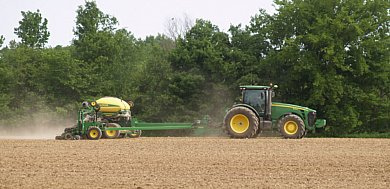Farmland values continue to climb, with farmers as buyers
Thursday, September 15, 2011

WOOSTER, Ohio — If you’re looking for a growing investment opportunity, your best choice may be the ground beneath your feet.
While the amount of land for sale certainly isn’t growing, returns per acre are increasing, and at a significantly high rate.
Ohio farmland values shot up 7.5 percent over last year, according to the U.S. Department of Agriculture’s recent numbers, with all-land values averaging $4,300 per acre.
The national average saw all-farm land values average $2,350 per acre, a 6.8 percent increase from 2010.
You’d be pressed to find a savings or deposit account with those kinds of returns in today’s economy, or even stocks or bonds with those types of returns. And investors seem to know.
Time is right
Barry Ward, an ag economist with Ohio State University, said low interest rates and the potential for significant returns are becoming big factors in people’s decisions to buy land.
“That tends to make certain investments look better than your (bank) interest or your risk-free bonds,” he said. “We’re seeing investors looking at farmland as a real viable option to the stock market.”
In many cases, those investors are turning out to be farmers who want to expand.
Ward, and several Ohio real estate agents, say the strong grain markets are a big reason for the increase.
Significant increases in commodity prices the last two years, and good yields have “driven some real good earnings by farmers and (landlords),” said Mike Weasel, a Realtor and director of business development for Wilson-Harvey Auction Group, of Hillsboro and Springfield, Ohio.
Cropland value alone increased by 8.6 percent in Ohio, while cropland nationwide is up 9.4 percent. Pastureland in Ohio is unchanged, averaging $3,000 an acre.
In Pennsylvania, average farmland values remained unchanged at $5,000 an acre.
However, all Corn Belt states saw an increase, ranging from 7.5 percent in Ohio, up to nearly 25 percent in Iowa.
Bright future
Ward said commodity prices are expected to remain high, with interest rates staying low — creating an ideal situation to buy land for farming.
“I suspect we’re going to continue to see some increases even from the point that we are now, due to the strength in the corn and soybean markets,” he said.
Keith Kennedy, chief land appraiser for Farm Credit Services of Mid-America, said rent values also are increasing, especially in the northwest part of Ohio where cropland is generally considered most valuable. Farm Credit assesses farmland rents each June, and this year noted a 27 percent increase in northwest Ohio.
He said some farmers in that region are paying $175 an acre to rent, while those in eastern Ohio are closer to $75-$100 an acre. The differences depend on how much of the farm is tillable, how much is wooded and the soil quality.
Different perspectives
Kennedy said the increases are good and bad, with a lot of good overall.
“It’s good for farmers in that it increases their net worth,” he said.
“They’re having to pay more for land, but grain has been pretty good the past few years and there’s a lot of farmers with cash on hand.”
The big concern among farmers and others buying land is whether commodity prices will remain high enough — and inputs low enough — to continue to turn a profit.
Kennedy said farmers are better structured to handle the volatility than in previous years, and said “there’s nothing in the short-term that says grain prices are going to come down.”
New territory
Weasel said the current commodity market is “well beyond anything we’ve ever experienced.”
He doesn’t see a decline in sight, but predicts the grain prices will continue to spill over into higher grocery store prices and put increased challenges on grain-dependent livestock farmers and ethanol companies.
He questions how long the current highs for soybeans and wheat can be sustained, and at what price to other industries, including the livestock sector.
Most experts say minor fluctuations in price can be overcome, partly because grain farmers continue to increase their crop yields and time spent in the fields with more efficient seeds and equipment. And, experienced farmers know that any farm commodity is subject to change — sometimes overnight.
Unknown factors
Weasel said it’s still too early, with too few sales to know what affect the exploration of Marcellus and Utica shale gas may have on land values in Ohio — especially those in the central and western part of the state. Most of the gas discoveries and land leases have been in eastern Ohio, and are still being made at this time.
In past decades, land values have been pushed up by pressure of developers and cities. This time, however, Weasel said it’s definitely the farmers who are driving up values, with developers contributing a smaller part of the demand.
“The developers are not on the sidelines,” Weasel said. “But there’s not as much development going on as there was a few years ago. … The farmers on contiguous land are the dominant buyers — they’re the investors.”
“If there’s ever been a time to be in (farming), it’s now,” Weasel said.




